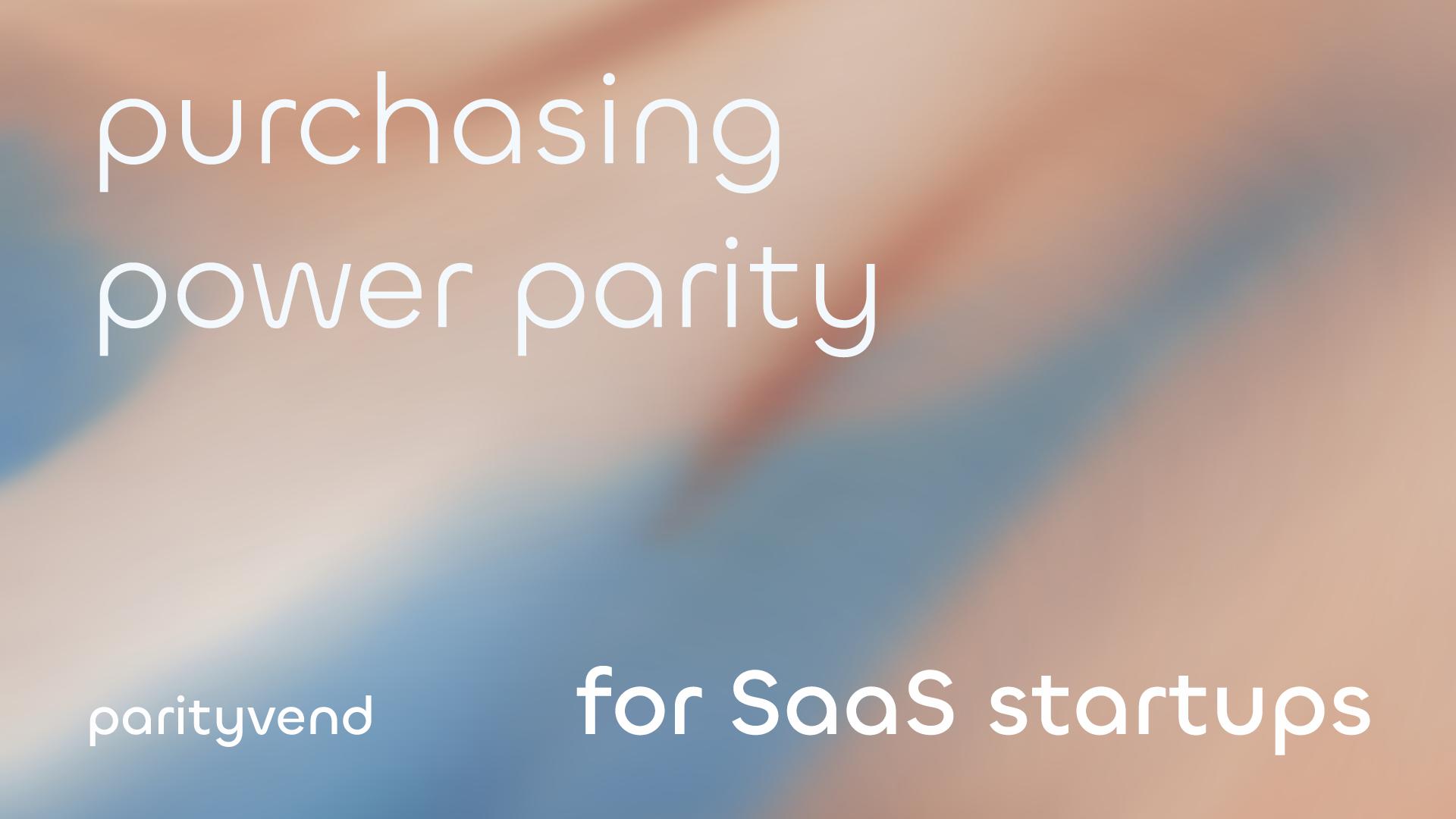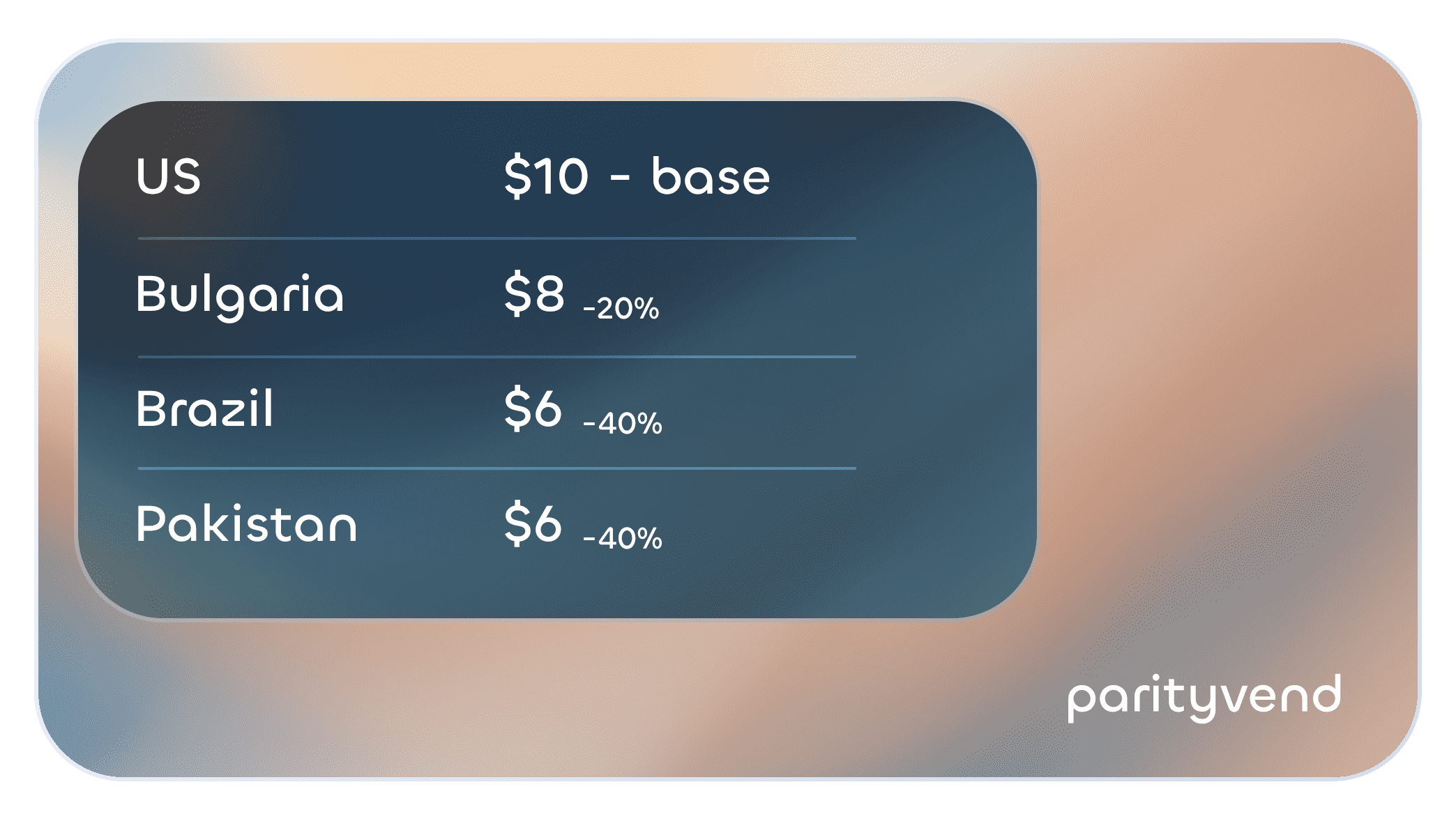Using Purchasing Power Parity for SaaS Startups
Ambeteco product center


Being an entrepreneur, or maybe even a shining founder of a new startup, you are likely on the lookout for fresh methods that could expand your startup's reach and, if lucky enough, even fuel growth. One game-changing approach - that is not related to advertising or any other paid methods - is becoming more and more popular each year is implementing Purchasing Power Parity (PPP) pricing. By using this economic concept, SaaS startups can unlock new untapped markets, make their customer base wider, and promote inclusivity on a global scale. But what exactly is "Purchasing Power Parity"?

The Scoop on Purchasing Power Parity
Simply put, the Purchasing Power Parity (PPP) theory says that money doesn't have the same value in every country. This means that the exact same amount of money can buy much more or less — depending on where you are. The PPP value tells us how much things cost in one country compared to another, considering how rich the countries are and how much people can buy with their money.
This may sound strange at first - so let's take an example of how PPP might look for your startup. A SaaS product priced at $10 per month might be a reasonable ask for customers in the US. Still, it could be too expensive for users in lower-income countries like Brazil, India, Argentina, or Pakistan. With PPP, SaaS startups can adapt their pricing to each country's buying power, making their services more accessible and affordable to a wider range of customers.
So, instead of having the same price of $10 everywhere, with PPP, you would instead reduce it for countries with lower purchasing power. An example PPP pricing for this abstract SaaS might look like this:

Why Implement PPP for SaaS Startups?
Adopting a PPP pricing strategy can bring numerous advantages to SaaS startups. It can help you navigate the global market's complex sides and explore new, previously unavailable opportunities.
Expanded Market Reach
One of PPP's biggest advantages is the ability to break into new markets and attract customers from regions where standard pricing would have been inappropriate. Unfortunately, not all countries have the same level of salaries as in the US. By offering location-based discounts, your SaaS startup can put its products within reach of a much larger audience — which will open up fresh revenue streams and increase your global growth.
Boosted Sales and Revenue
While this may sound strange, offering discounts can increase your overall revenue. By reducing your prices in lower-income regions, you make your product more affordable and open the door to a larger customer base — who would not have been able to buy your product before due to its unsuitable price. This strategy lets you gain more sales in emerging economies and expand into previously untapped revenue sources.
Inclusivity and Accessibility
SaaS products — including yours — have the potential to empower people and businesses all around the world. However, varying economic situations can often create obstacles to accessing your products. By integrating PPP pricing, you can show your dedication to inclusivity and accessibility. This approach helps make your prices fair to everyone and ensures that your offerings are affordable for customers across different economic backgrounds. Additionally, this commitment to inclusivity can also foster customer loyalty.
Building Brand Loyalty
Customers greatly appreciate it when startups acknowledge and respect their economic realities. By offering fair and accessible pricing through PPP, your SaaS startup can foster brand loyalty and transform their customers into "brand fans". This positive sentiment can lead to increased word-of-mouth marketing and a stronger brand presence across different markets.
Competitive Advantage
By offering location-based pricing, you can also differentiate your offers and position yourself as a more attractive and accessible option compared to competitors who do not take advantage of PPP. Not only will your products be more affordable than others, but by adopting PPP, you will also demonstrate your commitment to global inclusivity, showing your customers that you do care about them (while your competitors don't - shame on them).
Putting PPP Into Practice
While the benefits of PPP pricing are intriguing, actually implementing it requires a lot of planning and consideration. Here are some strategies and factors to keep in mind:
- Research: The foundation of any successful PPP pricing strategy is built on research and data collection. You will need to gather information on buying power, cost of living, and economic indicators of each country - and there are at least 190 countries in the world. You will need all this data to perform the pricing adjustments and ensure discounts are appropriately aligned with local economic conditions.
- Pricing Tiers: Based on the collected data, you will then be able to establish pricing tiers and segment your potential customer base accordingly. This can involve creating multiple pricing plans, each tailored to specific regions or income levels, as well as deciding on the discount sizes.
- Integration: Integrating PPP can be a complex process, especially when dealing with multiple pricing tiers or products, frequent currency changes, and the need to prevent potential abuse. To streamline this process, businesses can use automation solutions and APIs that dynamically adjust pricing based on the customer's location and buying power.
- Addressing Potential Abuse: As mentioned earlier, another concern with PPP pricing is the risk of abuse, such as customers using VPNs or proxy servers to fabricate their location and gain access to lower pricing tiers. For example, someone from the UK might try to use an Indian VPN to get access to discounts on your SaaS products - which will surely harm the integrity of your business operations. To reduce this risk, SaaS startups can implement anti-abuse measures, such as VPN detection or IP-block lists.
- Continuous Monitoring: Economic conditions and buying power can change over time, so it's important for you to continuously monitor and optimize your PPP pricing strategy. This can include periodical adjustments to purchasing power data, and refinement of anti-abuse measures — all to ensure the long-term effectiveness and fairness of the pricing model.
So, do we need PPP?
By using Purchasing Power Parity pricing, SaaS startups can unlock a world of opportunities and position themselves for sustainable growth in the global market. Still, while implementing PPP by yourself is possible, it can be a time-suck and a headache, especially when dealing with multiple pricing tiers, currency fluctuations, and concerns around potential abuse. With careful planning, data-driven decision-making, and the right tools and strategies in place, startups can navigate the complexities of international pricing. That's where ParityVend comes in – an innovative SaaS platform that automates the entire PPP pricing process for your digital products.
ParityVend: Streamlining PPP Implementation
ParityVend is a game-changing solution that simplifies the implementation of PPP for SaaS startups. With its user-friendly interface and powerful features, ParityVend takes the hassle out of PPP pricing, allowing you to go global in less than seven minutes. Here are some key benefits of using ParityVend:
1. No-Code and API Solutions: ParityVend offers both No-Code and API solutions, catering to businesses of all sizes and technical expertise levels.
2. Seamless Integration: ParityVend integrates seamlessly with your existing checkout process, ensuring a smooth and consistent experience for your customers.
3. Powerful Anti-Abuse Systems: ParityVend features robust anti-abuse systems, including anti-VPN, proxy, and TOR detection, to prevent potential misuse and ensure a secure and reliable experience.
4. Customizable Pricing Flows: With ParityVend, you can build exceptional pricing flows tailored to your specific needs, offering personalized and localized experiences for your customers.
5. Proven Effectiveness: Industry leaders like Netflix, Spotify, Apple, and Microsoft already adapt their pricing based on buying power. By using ParityVend, you can follow in their footsteps and unlock the same benefits.
Start using PPP and Unlock New Opportunities
Implementing Purchasing Power Parity isn't just a pricing strategy; it's a catalyst for growth and inclusivity. By embracing PPP and using solutions like ParityVend, SaaS startups can tap into new markets, attract new customers worldwide, and build a more accessible and inclusive global marketplace.
Don't let economic disparities limit your potential. Unlock new opportunities with PPP and drive your SaaS company to new heights of success. Partner with ParityVend today and experience the power of personalized, location-based pricing that truly resonates with your customers.
Learn more about ParityVend and the full list of its features on its official website:
https://www.ambeteco.com/ParityVend/
Get ParityVend now:
https://www.ambeteco.com/ParityVend/pricing/
Take a look at the live demos here:
API demo: https://www.ambeteco.com/ParityVend/api-demo/
No-Code demo: https://www.ambeteco.com/ParityVend/no-code-demo/






